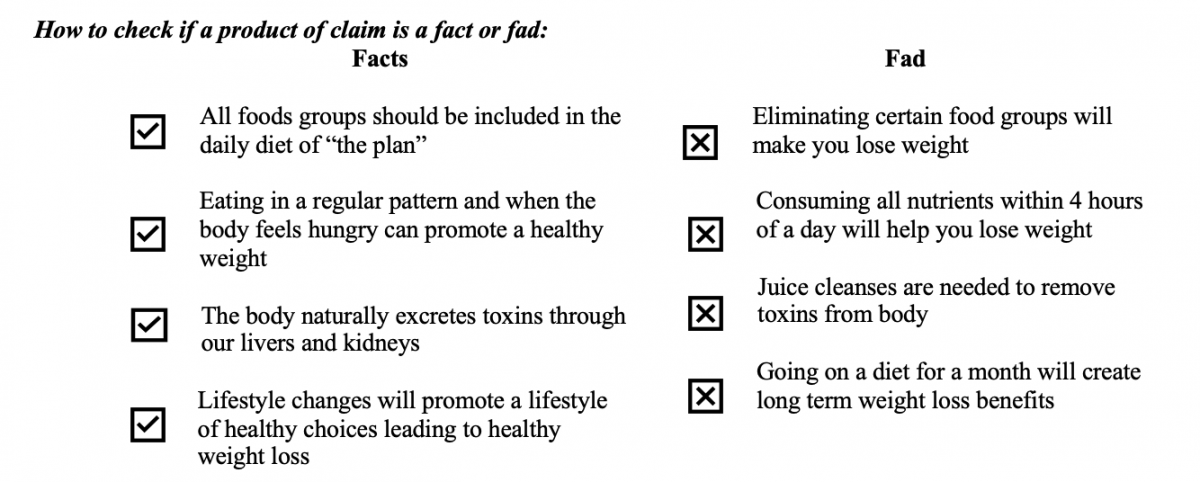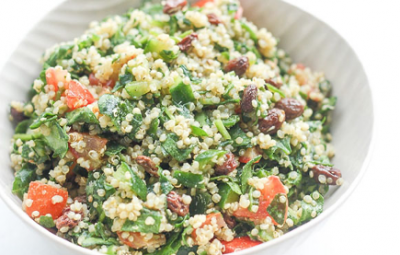Written by UConn Dietetic Intern, Valerie Mason
What is a fad diet?
Fad diets come and go as new research and new trends start to come out. Diets that claim, “rapid weight loss” or “no exercise needed”, or “see results fast” are likely fad diets and making false claims. These diets are often promoted and made popular by celebrities through social media, or you may see on television advertisements. Social media plays a role in many of our lives and serves to influence many to take on- and pay for these products that promise big results. In fact, many fad diets can have negative impacts on an individual’s health and may not have lasting results.
and making false claims. These diets are often promoted and made popular by celebrities through social media, or you may see on television advertisements. Social media plays a role in many of our lives and serves to influence many to take on- and pay for these products that promise big results. In fact, many fad diets can have negative impacts on an individual’s health and may not have lasting results.

Popular Fad Diets
Keto Diet
Many people believe The Keto diet is just a low carb diet. However, the Keto diet gets its name from the metabolic state your reaches when on this diet. This is known as ketosis, which is the process of your body breaking down ketone bodies from fat for energy instead of carbohydrates which your body and brain prefer.
When choosing to follow this diet, it’s important to realize that since the largest portion of your nutrients are coming from fat, it is important to realize what type of fats you are consuming. Trans fats (found in margarine or shortening) as should very rarely be included, as they provide no health benefits and can negatively affect your blood lipids like LDL cholesterol. When picking out fat options on the Keto diet it is important to use unsaturated fats like polyunsaturated (nuts and fatty fish), and monounsaturated fats (avocado and olive oil).
Yes, it is true that when your body is in ketosis, it is burning fats, however the myth of this diet is that you will be able to lose weight and keep off all the weight that you lose. The diet is hard to maintain and sustain and can be counterproductive to your health if not done under instruction from a medical professional.
Intermittent Fasting
This is a diet or eating plan that some people have found to work, but it can be hard to manage. The science behind intermittent fasting is that if your body is without calories, your body will switch from burning sugars to burning fat for energy. Doing so, your body has time to burn fats before the next eating period. This diet plan includes eating only 8 hours of the day. The remaining 16 hours you “fast” or do not eat. This diet can be problematic for those people with underlying health conditions. This is a diet that should be closely monitored and supervised for people with certain medical conditions like Diabetes.
Detox Diets
These diets often involve juicing, which is typically using a juicer to extract liquid from all sorts of fruits and vegetables, but probably means spending money on a juicer. Some people may think detox diets mean drinking more juice typically found at the grocery store, but that could mean taking in large amounts of sugar over and above the sugar the fruit gives us. Did you know that your body has a natural detoxication system? The body helps you detox toxins through sweat, feces, urine, and our livers. Ways to promote your body’s natural detoxification system include staying hydrated with water, eating plenty fruits and vegetables, and eating naturally fermented foods (sauerkraut, yogurt, etc.).
The Facts
Weight loss is not a quick and easy process and will probably involve some lifestyle changes depending on the individual. Everyone’s body is different which means a careful focus on what is most realistic for you is important. A safe weight loss is 1-2 pounds per week. Generally, to lose 1-2 pounds per week, an individual will need to burn 500-1,000 calories more than eaten per day through a lower calorie diet and regular physical activity. Any new physical activity plan should be discussed with your doctor. A key point to healthy weight loss is that you are getting essential nutrients, vitamins, and minerals in your daily diet. To put it simply- you want to be sure you are eating a variety of foods, minimizing the number of processed foods, watching portion sizes, drinking plenty of water and being sure you’re active every day!
Try something new!
Quinoa Spinach Power Salad
- ½ cup quinoa, uncooked
- 2 cups spinach, finely chopped
- 1 tomato, diced
- ½ cup cucumbers, diced
- ¼ cup raisins
- 1 + ½ tablespoon lemon juice
- 1 + ½ tablespoon extra-virgin olive oil
- ¼ teaspoon salt
- ¼ teaspoon ground black pepper
- In a medium bowl, rinse the quinoa a few times. In a medium saucepan, boil 2 cups of salted water. Add the quinoa and continue to boil for about 10 minutes until the quinoa is tender. Drain the quinoa and let it cool.
- In a large bowl, combine the spinach, tomatoes, cucumbers, raisins, and cooled quinoa.
- In a small bowl, make your lemon vinaigrette. Combine the lemon juice, olive oil, salt, and pepper. Pour onto the salad and toss to coat.
- Season to taste with more salt and pepper, if needed.
References:
- https://my.clevelandclinic.org/health/articles/9476-fad-diets
- https://www.health.harvard.edu/staying-healthy/should-you-try-the-keto-diet
- https://www.eatright.org/health/wellness/diet-trends/staying-away-from-fad-diets
- https://www.eatright.org/health/wellness/diet-trends/what-is-the-ketogenic-diet
- https://www.eatright.org/health/wellness/weight-and-body-positivity/what-a-healthy-weight-loss-plan-really-looks-like
- https://www.eatright.org/health/wellness/diet-trends/whats-the-deal-with-detox-diets
- https://www.hopkinsmedicine.org/health/wellness-and-prevention/intermittent-fasting-what-is-it-and-how-does-it-work
- https://www.aheadofthyme.com/2016/02/quinoa-spinach-power-salad-with-lemon-vinaigrette/
This material was funded by USDA’s Supplemental Nutrition Assistance Program (SNAP).
This institution is an equal opportunity provider.